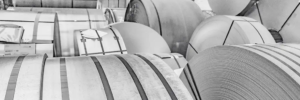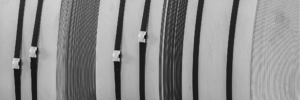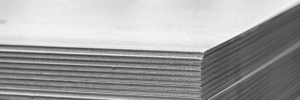| Quality | Standard | Possible coatings |
|---|---|---|
| CR380LA | VDA 239-100 | UC, EG, GI, GA, AS, ZM |
| Testing direction | Yield Point Re (MPa) | Tensil Strength Rm (MPa) | Elongation type 1 A50 (in %) | Type 2 A80 (in %) | Type 3 A50 (in %) |
|---|---|---|---|---|---|
| L | 380 – 470 | 450 – 570 | ≥ 20 | ≥ 19 | ≥ 20 |
| C % | Si % | Mn % | P % | S % | Al % | Ti % | Nb % | Cu % |
|---|---|---|---|---|---|---|---|---|
| ≤ 0,12 | ≤ 0,50 | ≤ 1,60 | ≤ 0,030 | ≤ 0,025 | ≥ 0,015 | ≤ 0,15 | ≤ 0,09 | ≤ 0,20 |
In the spectrum of micro-alloyed, cold-rolled steels according to the VDA 239-100 standard, the CR380LA grade represents a significant further development. It falls within the medium to upper strength range, offering an ideal balance between strength and formability. This combination of properties is crucial for the automotive industry, as it enables manufacturers to produce body parts that both meet high requirements for passive safety and contribute to weight reduction. The material was specifically developed for applications where conventional steels are no longer sufficient and higher load-bearing capacity is required. Like all grades in this standard, CR380LA is also exclusively designed for use in the automotive sector, where it plays a central role in the manufacturing of Body-in-White structures.
Properties
The outstanding performance of CR380LA is based on a precise coordination of mechanical and chemical properties. According to VDA 239-100, CR380LA must achieve a minimum yield strength (Rp0.2) of 380 MPa, with the minimum tensile strength (Rm) at 450 MPa. Despite these considerable strength values, the material exhibits a minimum elongation at break of 19%. This value is particularly remarkable for a steel of this strength class, as it allows for excellent cold formability. The chemical composition, like with other LA grades, is characterized by a low carbon content. Instead, the strength is achieved by adding micro-alloying elements such as titanium and niobium. These elements ensure a fine strengthening of the microstructure without negatively affecting weldability or cold formability. This means the steel can be easily processed using common welding methods, especially resistance spot welding. The high surface quality of the cold-rolled strip also makes it ideal for coating, such as hot-dip galvanizing, which provides optimal corrosion protection.
Applications
CR380LA is used in automotive production for a variety of components where increased strength is required without restricting design freedom due to insufficient formability. Typical applications include:
The combination of high strength and good formability makes CR380LA a versatile material for complex molded parts required in automotive body structures.
Conclusion
In summary, CR380LA according to VDA 239-100 is a modern material that bridges the gap between classic formability and increased strength. It’s a reliable solution for engineers and designers aiming for both significant weight reduction and improved crash safety. Thanks to its balanced mechanical properties and excellent workability, this steel significantly contributes to efficiency in series production and enables the development of vehicle generations that meet the highest demands for safety, efficiency, and sustainability. Its role as an essential building block in car body construction is therefore undeniable.
Delivery Forms

Ihr Ansprechpartner
Alex Bachmann
+49 2841/60041 120
+49 173/7545333
Alex.Bachmann@ESB-Group.com






